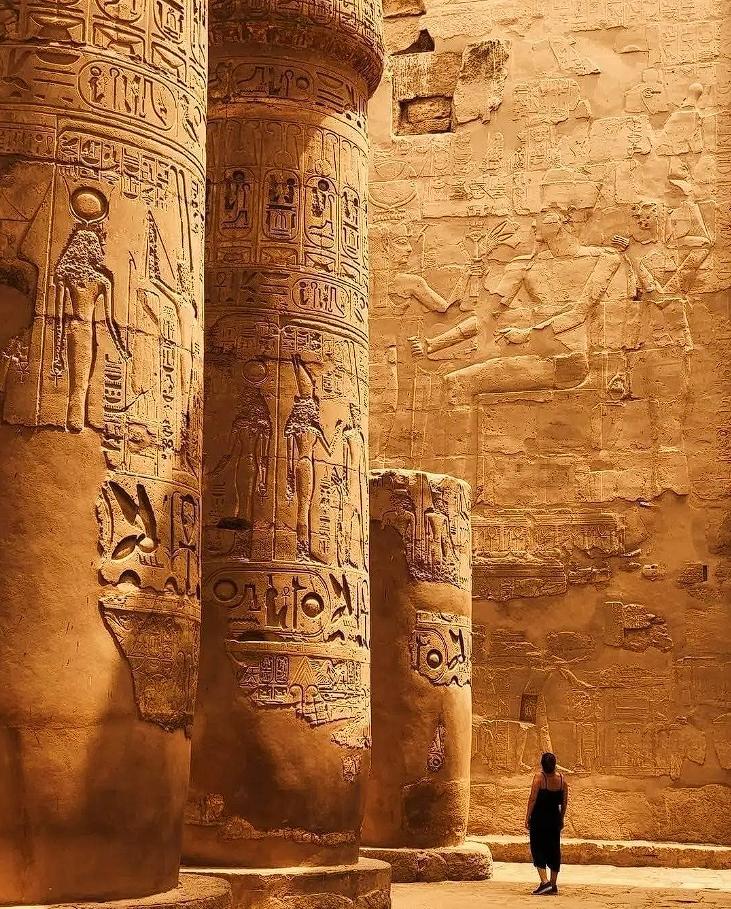“Enter the awe-inspiring Great Hypostyle Hall of Karnak, and you step into a realm of ancient Egypt’s most breathtaking architectural feats. Located within the sprawling Karnak Temple complex in Luxor, this monumental space, spanning 5,000 square meters, presents a forest of stone, a spectacle unparalleled in the ancient world.”

A Colossal Symphony: Pillars Etched in Mythic Echoes
- The Forest of Giants: A Monument to Creation:
- Rising from the earth, 134 colossal columns stand in ordered ranks, arranged in 16 stately rows. The two central rows, towering above the rest, reach an imposing 24 meters in height, each column measuring 10 meters in circumference.
- These mighty pillars, shaped to resemble blooming papyrus stalks, were not merely architectural supports; they were symbolic representations of the mythic papyrus swamp, the primordial landscape from which the god Atum emerged—self-created—from the chaotic waters of Nun at the dawn of creation. Here, in this vast hall, stone echoes myth, and divine origins are etched into the very fabric of the architecture.
- A Royal Legacy: Inscriptions Carved in Time:
- Though initially attributed to Horemheb or Amenhotep III, scholarly consensus now points to Pharaoh Seti I as the primary architect of the hall. He adorned the northern wing with finely detailed inscriptions, a testament to his reign and devotion.
- His son and successor, Ramesses II, completed the southern section, adding his own bold reliefs, a continuation of the royal narrative. This collaborative effort, spanning generations, transformed the hall into a living chronicle of pharaonic power, a visual history carved into stone.
A Testament to Grandeur: Sunlight and Stone in Eternal Dialogue
- The Sun’s Embrace: A Hall Transformed by Time:
- Today, with its roof long since vanished, sunlight floods the timeworn surfaces of the hall, revealing the intricate details of its construction. This transformation, wrought by time, does not diminish its grandeur; rather, it enhances its ethereal beauty.
- The interplay of light and shadow, casting the colossal columns in a perpetual dance, transforms the hall into a space where the past and present converge, where the echoes of ancient rituals blend with the silence of time.
- A Legacy Endures: Royal Power and Unmatched Artistry:
- The Great Hypostyle Hall of Karnak stands as a profound testament to divine ambition, royal power, and the unmatched artistry of ancient Egyptian builders. It is a space where the aspirations of pharaohs are immortalized in stone, where the boundaries between the earthly and the divine blur.
- This hall, therefore, is not merely an archaeological site; it is a living monument, a tangible link to a civilization that sought to transcend the limitations of mortality through the enduring power of architecture.
Conclusion
“The Great Hypostyle Hall of Karnak, a forest of stone rising from the sands of Luxor, remains a spectacle of ancient Egyptian grandeur. It is a place where myth and history intertwine, where the aspirations of pharaohs are etched into colossal columns, and where the enduring legacy of a civilization continues to inspire awe. This hall, therefore, is more than just a structure; it is a narrative, a testament to the enduring power of human creativity and the enduring quest for immortality.”

CÁC TIN KHÁC
Mary Walton: The Forgotten Inventor Who Helped Clean Up America’s Cities
Tomb of Queen Nefertari in the Valley of the Queens, Egypt
Discover the Hypostyle Hall of the Temple of Hathor at Dendera
Venus de Losange: Unveiling the Mystery of a 20,000-Year-Old Paleolithic Icon